一、创建springboot工程
使用idea工具,选择file->new->project,选择spring initialzr
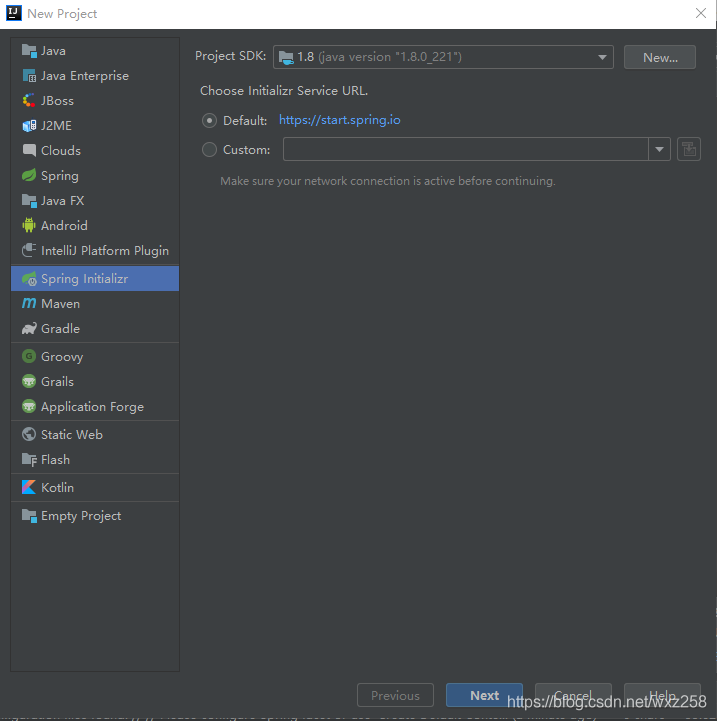
输入springboot工程基本信息,本示例命名为“camunda-demo1”, jdk版本选择8
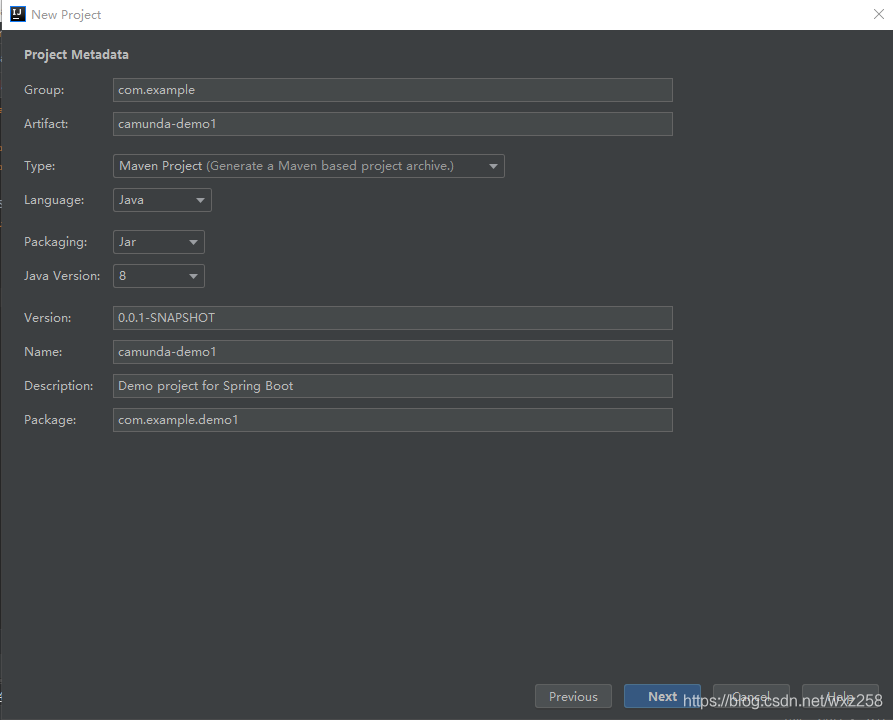
在选择springboot组件的时候,需要选择spring web、jdbc api、mysql driver 这三个组件。点击下一步完成即可。
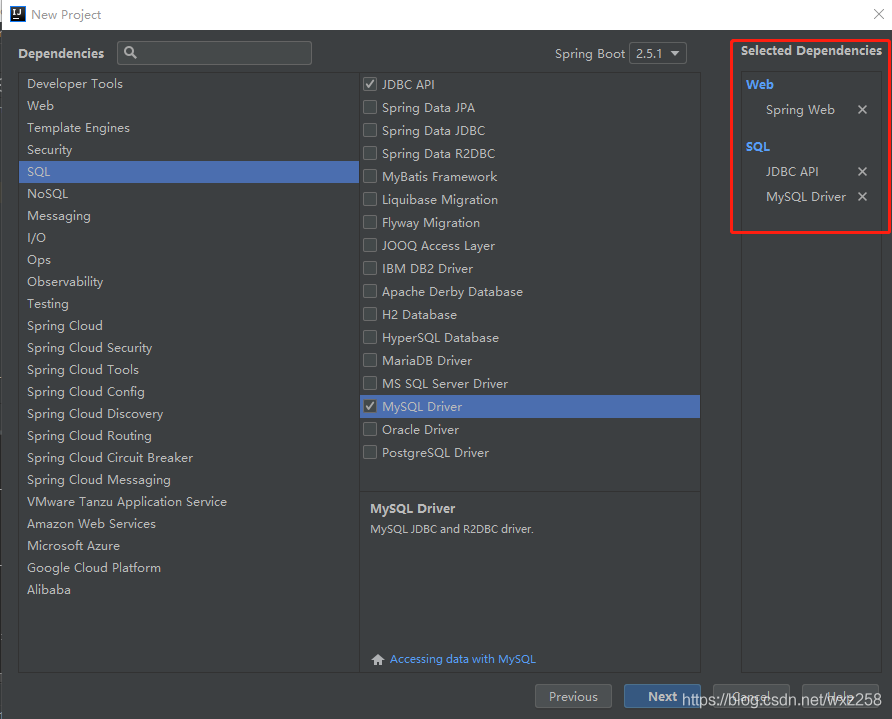
二、修改maven配置
2.1、修改springboot版本号
由于camunda版本与springboot版本有匹配关系,所以需要修改springboot版本为2.4.3,
官方推荐camunda7.1.5版本使用spring boot 2.4.x版本
具体配置参考camunda官方说明文档:https://docs.camunda.org/manual/7.15/user-guide/spring-boot-integration/version-compatibility/
pom.xm代码片段:
|
1
2
3
4
5
6
|
<parent> <groupid>org.springframework.boot</groupid> <artifactid>spring-boot-starter-parent</artifactid> <version>2.4.3</version> <relativepath/> </parent> |
2.2、引入camunda包
由于本示例要使用camunda流程引擎、web界面、rest服务接口,所以需要导入camunda-bpm-spring-boot-starter、camunda-bpm-spring-boot-starter-rest、camunda-bpm-spring-boot-starter-webapp这三个依赖包,如果仅仅是使用流程引擎,只需要引入camunda-bpm-spring-boot-starter就可以了。
完整的pom.xml文件如下:
|
1
2
3
4
5
6
7
8
9
10
11
12
13
14
15
16
17
18
19
20
21
22
23
24
25
26
27
28
29
30
31
32
33
34
35
36
37
38
39
40
41
42
43
44
45
46
47
48
49
50
51
52
53
54
55
56
57
58
59
60
61
62
63
64
65
66
67
68
69
70
71
72
73
74
75
76
77
78
79
80
81
82
83
84
85
86
87
88
89
90
91
92
93
94
95
96
97
98
99
100
101
102
103
104
105
106
107
108
109
110
111
112
113
114
115
116
117
118
119
120
121
122
123
|
<?xml version="1.0" encoding="utf-8"?> <project xmlns="http://maven.apache.org/pom/4.0.0" xmlns:xsi="http://www.w3.org/2001/xmlschema-instance" xsi:schemalocation="http://maven.apache.org/pom/4.0.0 https://maven.apache.org/xsd/maven-4.0.0.xsd"> <modelversion>4.0.0</modelversion> <parent> <groupid>org.springframework.boot</groupid> <artifactid>spring-boot-starter-parent</artifactid> <version>2.4.3</version> <relativepath/> <!-- lookup parent from repository --> </parent> <groupid>com.example</groupid> <artifactid>camunda-demo1</artifactid> <version>0.0.1-snapshot</version> <name>camunda-demo1</name> <description>demo project for spring boot</description> <properties> <java.version>1.8</java.version> </properties> <dependencies> <dependency> <groupid>org.springframework.boot</groupid> <artifactid>spring-boot-starter-web</artifactid> </dependency> <dependency> <groupid>org.springframework.boot</groupid> <artifactid>spring-boot-starter-jdbc</artifactid> </dependency> <dependency> <groupid>mysql</groupid> <artifactid>mysql-connector-java</artifactid> <scope>runtime</scope> </dependency> <dependency> <groupid>org.springframework.boot</groupid> <artifactid>spring-boot-starter-test</artifactid> <scope>test</scope> </dependency> <dependency> <groupid>org.camunda.bpm.springboot</groupid> <artifactid>camunda-bpm-spring-boot-starter</artifactid> <version>7.15.0</version> </dependency> <dependency> <groupid>org.camunda.bpm.springboot</groupid> <artifactid>camunda-bpm-spring-boot-starter-rest</artifactid> <version>7.15.0</version> </dependency> <dependency> <groupid>org.camunda.bpm.springboot</groupid> <artifactid>camunda-bpm-spring-boot-starter-webapp</artifactid> <version>7.15.0</version> </dependency> </dependencies> <build> <plugins> <plugin> <groupid>org.springframework.boot</groupid> <artifactid>spring-boot-maven-plugin</artifactid> </plugin> </plugins> </build> </project> |
三、修改application.yaml配置
打开工程目录下的main\resources\application.yaml文件,如果没有该文件,手动新建一个,录入如下信息。
|
1
2
3
4
5
6
7
8
9
10
11
12
13
14
15
16
17
18
19
20
21
22
23
24
25
26
27
28
29
30
31
32
33
34
35
36
37
38
39
40
41
42
43
44
45
46
47
48
49
|
# find more available configuration properties on the following pages of the documentation. # https://docs.camunda.org/manual/latest/user-guide/camunda-bpm-run/#configure-camunda-bpm-run # https://docs.camunda.org/manual/latest/user-guide/spring-boot-integration/configuration/#camunda-engine-properties camunda.bpm: generic-properties.properties: javaserializationformatenabled: true admin-user: id: demo password: demo run: # https://docs.camunda.org/manual/latest/user-guide/camunda-bpm-run/#cross-origin-resource-sharing cors: enabled: true allowed-origins: "*" # datasource configuration is required spring.datasource: url: jdbc:mysql://127.0.0.1:3306/camunda715?characterencoding=utf-8&useunicode=true&usessl=false&zerodatetimebehavior=converttonull&servertimezone=asia/shanghai driver-class-name: com.mysql.cj.jdbc.driver username: root password: root # by default, spring boot serves static content from any directories called /static or /public or /resources or # /meta-inf/resources in the classpath. to prevent users from accidentally sharing files, this is disabled here by setting static locations to null. # https://docs.spring.io/spring-boot/docs/current/reference/htmlsingle/#boot-features-spring-mvc-static-content spring.web.resources: static-locations: null |
本示例使用的是mysql数据库,数据库url、username、 password 跟后面数据库信息保存一致。
四、创建mysql数据库
camunda默认使用已预先配置好的h2数据库,本示例使用mysql数据库,需要提前创建mysql数据库并导入camunda建表脚本。
为camunda平台创建一个数据库模式,名称为camunda715
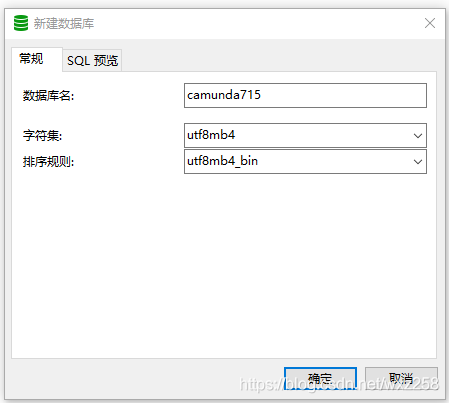
导入sql脚本。执行创建所有必需的表和默认索引的sql ddl脚本。这些脚本可以在configuration/sql/create文件夹中找到。共2个脚本,都需要导入。
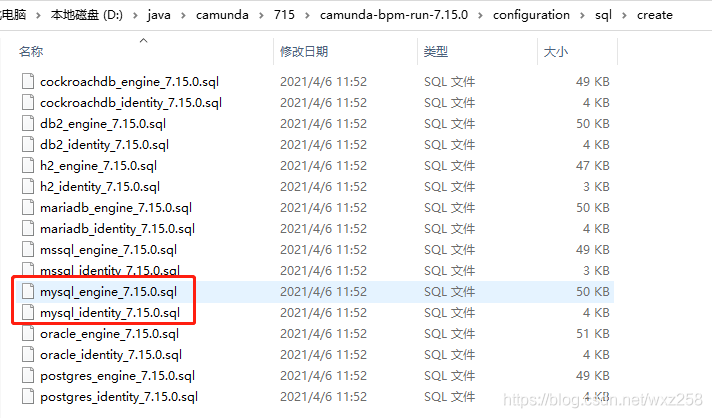
导入完成后的表结构,共40张表:
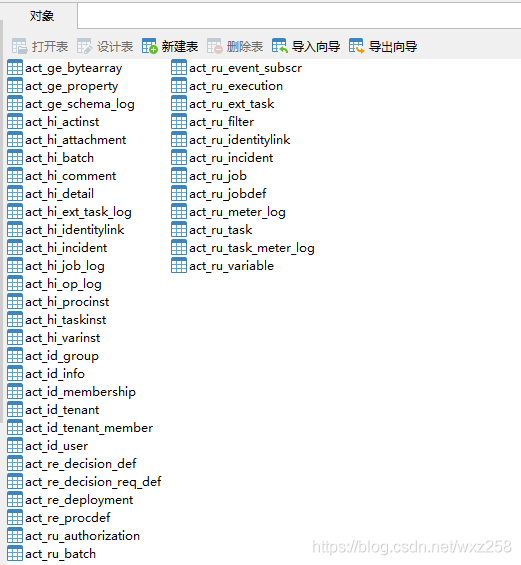
详细配置方法参考:https://lowcode.blog.csdn.net/article/details/117564836
五、启动springboot工程
创建springboot工程的时候,自动生成了springbootapplication启动类,运行改类启动即可。
|
1
2
3
4
5
6
7
8
9
10
11
12
13
|
package com.example.demo1;import org.springframework.boot.springapplication;import org.springframework.boot.autoconfigure.springbootapplication;@springbootapplicationpublic class camundademo1application {public static void main(string[] args) {springapplication.run(camundademo1application.class, args);}} |
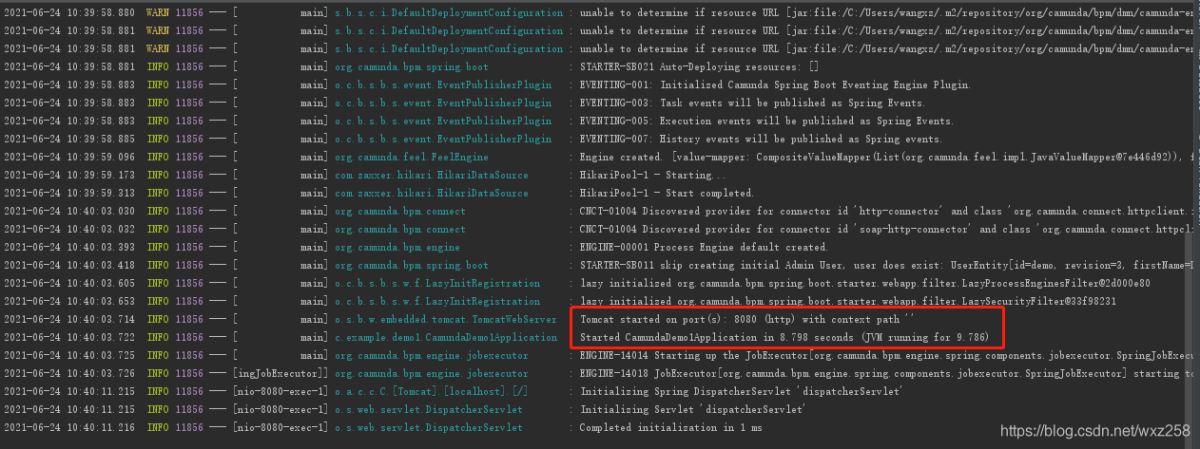
六、登录访问camunda
访问:http://localhost:8080,
默认账号密码demo/demo
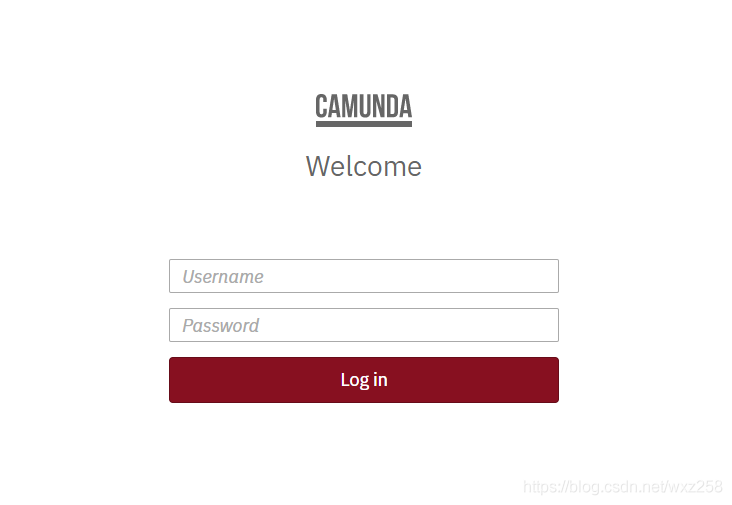
登录成功后进入camunda控制台
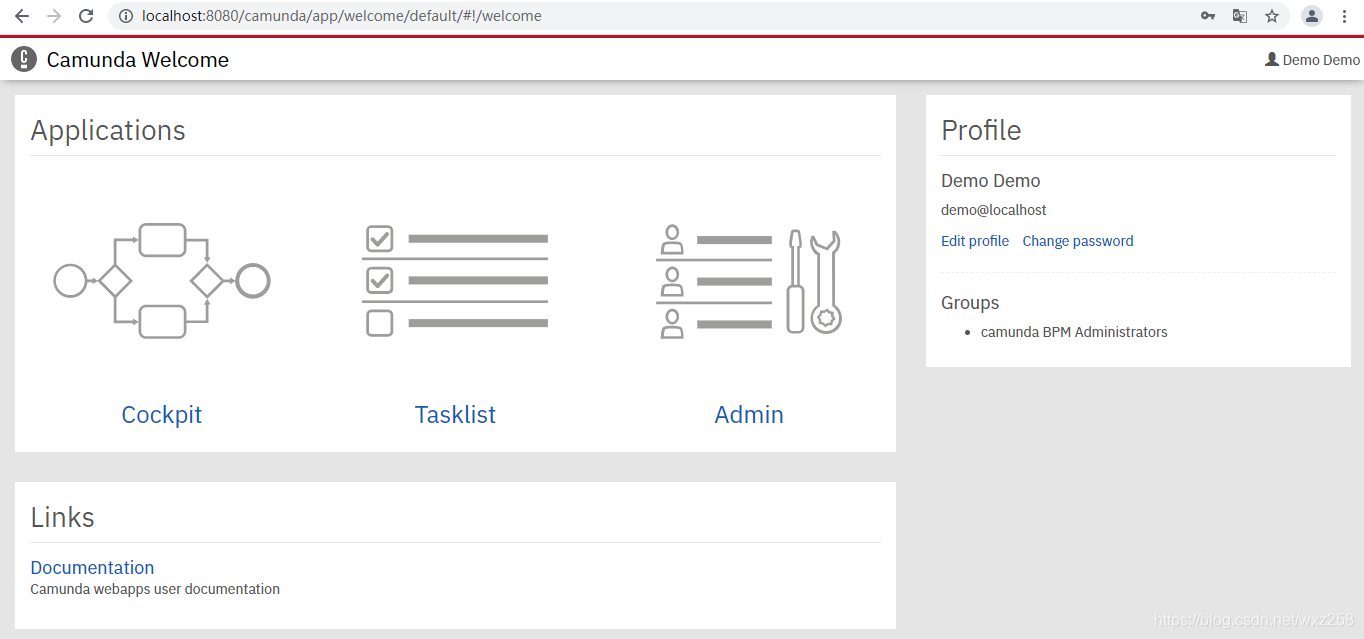
至此,完成了springboot2.4.3+camunda7.15+mysql的集成,后续的如何设计流程、如何启动流程、如何审批流程等操作,跟非springboot方式是一致的,请参考前面的文章。
https://lowcode.blog.csdn.net/article/details/117518828
https://lowcode.blog.csdn.net/article/details/118055189
以上就是springboot整合camunda+mysql的集成实现方法的详细内容,更多关于springboot整合camunda的资料请关注服务器之家其它相关文章!
原文链接:https://blog.csdn.net/wxz258/article/details/118182939















